Coppicing/Pollarding
- Brianna
What is Coppicing and Pollarding?
Coppicing and pollarding are two methods of tree trimming that allows us to continually harvest wood from the same trees while keeping them healthy for centuries. They produce a sustainable supply of timber for many generations while enhancing the natural state for wildlife and native plants.
Why we use Coppicing and Pollarding in Permaculture.
- Provide continuous supply of sustainably-harvested wood for:
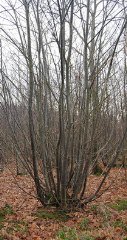
Coppiced Tree - Thermal Mass Rocket Stoves for home heating
- Wood Gasification Units for energy generation and auto/truck fuel
- Increase the biodiversity of the CSC property
- Support the hydrological cycle of the area
- Sequester carbon and humus in the soil
We teach the fundamentals of coppicing and pollarding in our Permaculture Course.
Coppicing/Pollarding ExplainedDating back thousands of years in Europe, coppicing and pollarding were used to continually harvest juvenile shoots off the same trees for fuel and craft materials. The concept is simple: by cutting a deciduous tree when it is dormant, you allow it to send up fresh shoots in the spring. These are harvested again when they reach the desired size — anywhere from 4 to 25 years. The best trees for either technique are deciduous trees that don’t “bleed” too much (such as maple). Oak, hazel, ash, chestnut, and willow work well.  The main difference between the two methods is that coppicing occurs at ground level while pollarding is done 8-10 feet high to prevent browsing animals from eating the fresh shoots; typically, coppicing was done to manage woodlands and pollarding was done in a pasture system. Coppicing a tree produces multiple stems growing out of the main trunk — suitable for firewood, fencing, tool handles, and many more woodland crafts. A properly coppiced woodland, harvested in rotational sections called coups, has trees and understory in every stage and is a highly effective method to grow a fast supply of naturally renewing timber. By working on a rotation we are assured of a crop somewhere in the woodland every year. Pollarding (from the word “poll,” which originally meant “top of head”) has been used since the Middle Ages — in fact, there are still stands of continuously pollarded trees that date to that time. Today, it is a technique that can be used in very urban environments to prevent trees from invading utilities or sewers . . . but its historical use of a wooded pasture system also fits into a permaculture method very well — stacking functions to get more yield out of one area. What makes these methods so appealing is that by keeping the tree in a perpetual juvenile state, they actually extend the life of the tree by hundreds or sometimes even thousands of years. Diseases rarely have time to take hold of the young growth and weather elements do not affect trees of short stature so they live much longer than their unpruned counterparts. And, because permaculturists don’t like to do more work than we have to, these methods actually reduce work two ways: by harvesting wood that is already partially dry (during the dormant season), and by growing firewood to just the right size and no more — less need to split and stack wood for drying. Pre-industrial Europeans thought it was a waste of human energy to grow a tree to a huge size just to kill it, split it, and have to replant . . . I’m kinda liking their mindset. What Makes This So Awesome?Well, everything! Both methods provide a renewable, carbon-neutral energy source. Let me say that again: a renewable, carbon-neutral energy source. Correct me if I’m wrong, but isn’t energy kind of a big deal these days? What coppicing/pollarding experts are saying here is that we actually can have it all — a sustainable, clean energy source that will meet all of our needs . . . including fueling our vehicles. Those things are grand, but these techniques supply a plethora of other benefits too. Like: improved soil and water quality, natural woodland protection (because these methods work so well, there will be less and less need to cut mature trees), labor reduction (replanting every year? so old-school), and regeneration and toxic clean up. Hm. A lot of problems on our planet can be corrected and eliminated by just planting some trees.  The Flora and Fauna and All That JazzTurns out, coppicing also fosters a huge jump in biodiversity because of the bursts of sunlight that hit the forest floor. Many kinds of woodland flowers, butterflies, and birds thrive in coppiced woodlands and are not found in other areas. In fact, some rare butterflies have a very close association with regularly coppiced areas. Also, the different stages of woodland vegetation in a coup provide a wide variety of habitat for wildlife.
How it WorksTo perform either method, the tree must be pruned severely – either to the ground or just around the trunk. It’s highly recommended that these techniques are only performed on young trees since they are far more receptive to pruning and healing — and by keeping them young by cutting their fresh growth every few years, the trees will actually live longer by avoiding many of the diseases and other issues of old trees. What makes these methods work so well is that the selected trees will already have a fully developed root system so their regrowth will be extremely fast. By performing regular pruning, the associated root die-back will also work to increase the humus content of the soil right around the tree to create a nutrient-rich environment . . . helping the tree even more. 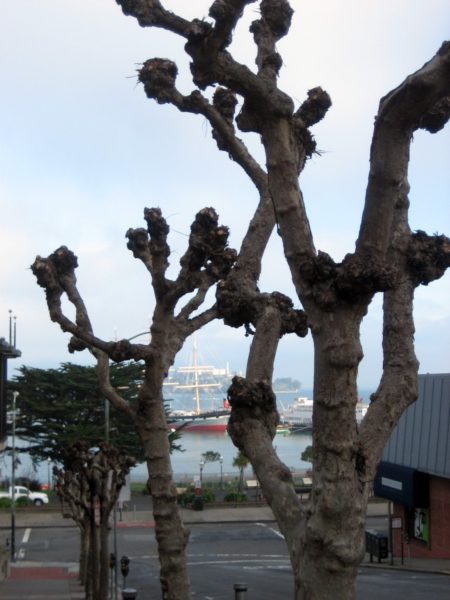 Who’s Doing It? While coppicing and pollarding are making a comeback in Europe for ecological, rather than economical, reasons, they’re starting to make an appearance in the United States for the first time as well; cities like San Francisco use pollarding to co-exist with their urban trees without interference in utility or sewer lines. Several universities throughout the Midwest and Northeast recently worked (early 2012) with the State University of New York on a Willow Biomass Crop Feedstock Development project which looks promising for the future of perennial energy crops, and Cornell also started a separate study in July of 2012 about the bioenergy capablities of willow with one goal being to use the shrub to improve marginal lands and show farmers that it is a viable crop. Notably, Permaculture guys Dave Jacke and Mark Krawczyk have collaborated on a forthcoming book that looks like it will change the nature of thought in the United States towards woodland management and possibilities. Here’s the link for their project: Coppice Agroforestry. 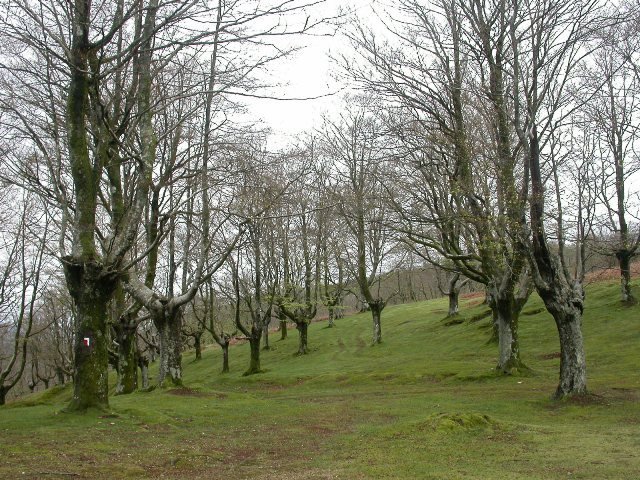 Creative Applications We can even stack these functions and put the tree crops in a pasture system. Now we’re getting fuel and meat/fiber from one plot. It really doesn’t take that much space to be sustainable. One of the most exciting aspects of these methods is producing a sustainable supply of timber for fuel! Willow is very receptive to either method and is also one of the trees of choice for biofuel . . . and gasification. We can heat our homes and run our vehicles on plants that want to grow! For a creative detour, we’ll explore the possibilities with just one plant, the willow. Why is this one species so exciting? From a growing standpoint, willow is:
Plus, environmentally it:
And it can be used for:
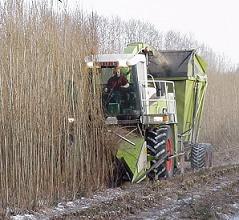 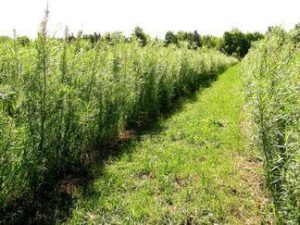 It’s important to note that the willow example is not intended to become another industrial monoculture and an excuse to clear-cut more land, but rather to show that we have options as we transition bare-open-erodible farm land to a more permanent-agricultural system. In a permaculture designed system, perhaps hazelnut could be grown-in with the willow and only a partial harvesting of nuts, wood, and basket weaving material would be harvested each year. If ducks were rotated through to provide nutrients and keep the grass down there would be another crop from the same property. The possibilities are endless . . . It’s obvious that with our modern technology and knowledge we have a wide array of choices for sustainability at our fingertips now! Bringing It HomeHopefully you can see why we are so excited to implement these methods on our CSC property! Our linear food forests, hedgerows, orchard conversion, and the willows that will hold our chinampas in place, all will have some sort of coppicing and/or pollarding applied to the system. The beauty of permaculture is that it supplies hope in a world that so often seems frantic and out of control. With all the worry over rising fuel costs and the implications that carries, we can rest easy knowing that it really is possible to take care of ourselves and our families — as long as we continue to respect the wisdom of the earth. Added Oct. 2021
|
Bri Wrench earned her Permaculture Design Course Certificate from Midwest Permaculture in the fall of 2012 and currently homesteads on a small, rented farm in central Ohio. She and her husband Kenny are looking to buy property to start a permaculture demonstration farm. |
[contentblock id=10]

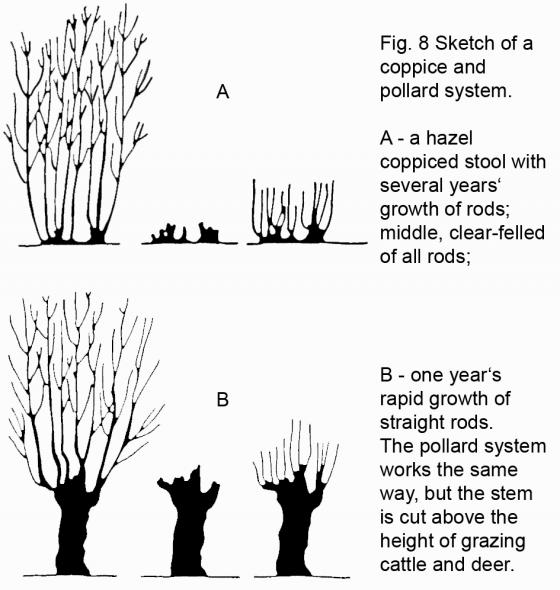
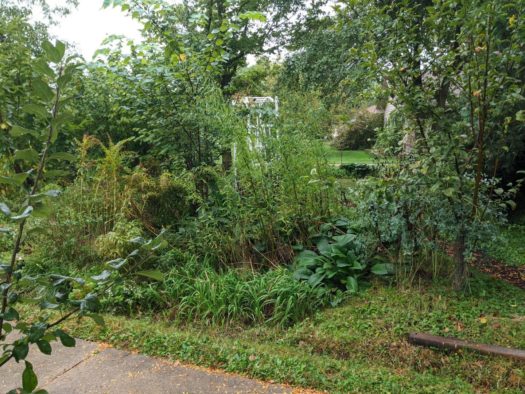

25 thoughts on “Coppicing/Pollarding”
In Canada we have a Maple species that is called the Manitoba Maple. It’s not that attractive but it’s a speed demon for growth. It also propagates by seed so easily that every spring we pull out millions of them from from our garden. Although it is a type of Maple, it might be good for this purpose too. I see pollarded ones in yards of houses everywhere.
But they do get infested by aphids every year, and the aphid poop spreads sticky liquid everywhere underneath them, which is not great for the paint on houses and fences. If their growth is controlled they are ok for ornamental purposes, but I’m wondering about the usefulness of the wood, because nothing else grows anywhere near as fast in Canada, not even Aspens and Poplars.
So glad to have found this page! I noticed pollarding when traveling in Europe in spring/summer in the ‘70’s, so recognized it when living in San Francisco in the ‘80’s. I had hazarded the guess as to a sustainable and relatively easy source of firewood, but had not considered the soil-building aspects. Now retired and on five acres of rundown land, mix of open meadow and woods, I am devoting my years here to developing a permaculture environment for future generations of our family. I am particularly interested in coppicing for ash trees as we have a few that are still producing seeds, but have signs if emerald ash borer and am wondering if coppicing might provide ash wood without perpetuating emerald ash borer populations.
Hello,
I am looking to purchase 14 – Platanus acerfolia ‘Bloodgood’ – 5.56″cal pollarded trees for the fall or next spring. Can you help me find them? If not Platanus, I am open to a different tree.
I am unaware of any pre-polarded trees for sale, they might be out there but I don’t know of them.
I would get them as young as possible and pollard them myself (or for the client) in situ.
We have a large manmade lake here in north central Pa. We have had beavers move in this year. They are coppicing aspen trees on the shores and along the stream flowing from it. They cut them into suitable lengths, float them across the pond, and drag them down the bank to the stream. They have a lodge downstream where another stream has joined the first stream. I did not know what coppicing was but then I realized I had seen something like it on a show from England that discussed it. Now I need to drive by a cattle pasture I saw in September that seems to have pollard trees all through it. Interesting concept. Some of the coppice forests seem to be attractive. The pasture with pollard trees seemed a little strange but now I know why, it makes sense as there were cattle present.
But has no one actually looked at the trees that result from these practices? they are ghastly, ugly mutants with none of the beauty of a real tree. I would rather use corn stalks for fuel than these utterly deformed trees. I like bonsai and have several trees but the pruning is done to create beauty, not to create nasty Quasimodos just to make wood you don’t have to split for firewood. There are so many ways I don’t buy into the entire concept of ‘natural’ as if anything humans do is unnatural since somehow we are not part of nature and are not evolved in the same way as all living things. But pollarding is unnatural and ugly. pragmatic in the middle ages when the goal was survival but now I want trees that look beautiful and follow their natural form. Even better, prune to follow bonsai aesthetics and help them be more beautiful than they would be without the tribulations of nature’s vagaries.
You’re certainly allowed your aesthetic opinion, however I would point out that aesthetics is last on the scale of permanence. Form should follow function.
Coppicing and pollarding are both natural responses of the trees to losing branches. Essentially we’re obtaining human function without destroying the ecology. Corn stalks or many of the other possible options do obliterate entire ecologies.
Being connected to that which provides for you is an essential requirement to the ethics of permaculture.
Totally agree with you Milton. Culturally trained aesthetics have a small consideration in functional spaces. One persons deformed is another’s sign of good practices. I have seen Pollarded trees in Lebanon over 800 years old. Amazing practice creating a long lasting resource. Working with nature.
Do what you want on your own land, but this practise will prevent at least some of the whole sale destruction of the entire northern boreal forest in Canada and elsewhere. What was once the second largest forest in the world is amost gone now, and what remains needs to be protected.
I have seen it from above, and it’s NOT pretty! For as far as the eye can see, in every direction, all day long, on fight across northern Canada, there forest does not exist anymore. The areas that are now being clear cut will never regrow. I happen to think that any kind of tree looks a lot better than the desert that clearcutting leaves behind. And it’s a far healthier ecosystem for all of the life forms there. The logging roads also contribute to horrendous destruction as well. The loss of those millions of miles of wilderness and the animal habitat it used to provide makes most normal people weep!
Besides, why do you object to the shape of trees that you will never see? I think you are just a right winger spewing anger, as they all do. If this can partially preserve the areas where it’s done, plus completely prevent vast other areas from being clear cut, I’m all for it, whatever it looks like!
Very interesting topic. I am currently dking small coppicing trial using our local mopane tree. The outcome is promising. I am thinking to do pollarding trial using the same species. I learnt a lot on this page and would like to learn more.
David Jacke has a forthcoming book coming on the subject. http://www.coppiceagroforestry.com/
I went to the Kickstarter page and looked at the comments and can’t tell what is happening with the book. It looks like this started 7 or more years ago and there are just months posted for the comments, not whether they are current (2017) or years old!
I believe the years are down the middle. They are taking their sweet time with it, knowing Dave they are doing it right. Their blog also has more information but no updates on the status of the book lately.
I live in Vermont. When is the best time to do the cutting? Late fall? Dead winter? Or early spring? Is there a diameter that is too large and should be avoided? I’m thinking mostly of firewood.
Best bet would be when the tree is dormant, so when the daytime temperature is below freezing. Every species is different in terms of what size is too big. You may have to experiment to find out. Maybe start with the smallest size that meets your needs and move up from there? There is a book coming out on the subject from Dave Jacke but not sure how soon.
I always wondered what the difference was between these 2 methods. Thanks! I plan on a pollard lot of black locust for firewood, which I would argue has a greater benefit than willow, due to the denser wood and bee forage. Pollard to avoid the thorns at ground level.
What would we the best method for a windbreak, pollard or coppice?
I’m thinking of using honey locust, but would like to experiment with timing so they produce sugar pods for chicken feed.
Hi Corey, Black locust is a good call over willow for firewood. We have a neighbor with a thermal mass rocket stove and he says willow just doesn’t burn hot enough to keep the stove running. For a windbreak, coppice is the more typical technique.
For a windbreak it might be best to alternate with one coppice tree then one pollard tree. That way you would have bushiness in both the low area and the high area. Or pollard them all and plant another species with a bushy shape near the ground between or behind them.
In Australia many of our natives are used to natural coppicing from bushfire. Callistemons, for example, are being coppiced more and more by homeowners imitating natural events.
In other parts of the world animals do the work of pollarding. When humans do it we are just doing what is natural for many trees to encounter in their native environment.
Quick note on the coppicing: I remember from my thesis work that the standard coupe (area of the coppiced woodlot cut in a given year) was not supposed to be more than 3 acres and not less that 1/4 acres. I think there were also considerations of what percentage of the coppice lot was cut in any given year. Not more than a third? Maybe? I don’t remember that part clearly. I remember the coupe size, though.
Why?
My understanding is that smaller than a quarter acre doesn’t allow the sunlight to reach the ground and shade inhibits stools re-sprouting (note: this data comes from England which is fairly far north. A coppice lot in Belize is not likely to need a quarter acre if my understandings of the rationale are right). More than 3 acres has to do with the preservation of the smaller critters in the forest, who have to walk, hop, or fly to their new homes.
My favorite iterations of agroforestry always seek to preserve the overall tree-dominant biome even while removing canopy in whatever pattern has been chosen. 99% of both pollution and repair is in the accumulation of the impacts of small habits. It’s a rare singular instance that completely flips something on its head.
I’m a bit confused. I’ve seen a single tree coppiced and there is no reason that you couldn’t have as many acres in coppice as you would want. It sounds like you mean within a larger forest in the first instance and contiguous acres cut for the second. There is no functional reason that either has to be a limitation if you design your system correctly.
Yes, you can coppice a single tree, I was talking about sizing the coupes within a coppice lot, and was basing it on what my research has yielded as the historic patterns in the UK. I’m not sure what you mean by 1st and 2nd instances; for now I am assuming the 1/4 acre minimum and 3 acre maximum? In which case, yes, a coppice lot if managed correctly is a functional forest, and yes, 3 contiguous acres. One of my concerns is the continuity of the ecology. You seem to have an idea of a different way to design the system such that a single coupe of more than 3 acres (and more than 30% of the larger coppice lot?) would not be an issue. Do share. And include the geographic area you are basing your understandings on, as that might be part of the differences of opinion here.
I was referring to the min/max scenarios that you were suggesting.
It certainly all depends on the situation. I would not suggest turning multiple acres of forest into coppice generally and only with much observation. However, say an 8 acre field would be improved by switching from a corn/soy rotation (an ecological wasteland and the standard here in the midwest) to coppice.
I think as important as maintaining the current ecology is creating the space for a new ecology to emerge.